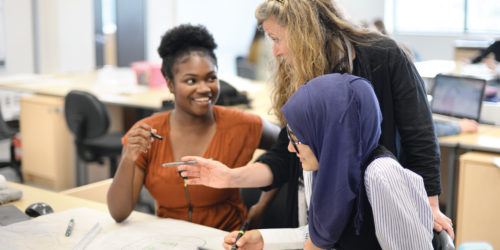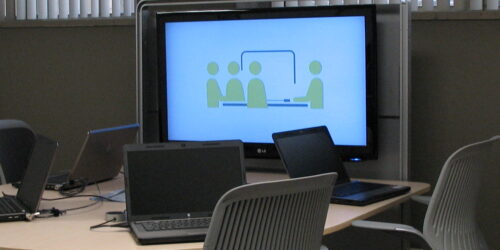
Effective Group Work
What does the research say about group work and learning?
How can I best create groups that work efficiently and collaboratively?
Relevant Policies
As per the Evaluation of Student Learning Procedure, faculty are responsible for the following.
- Create and post guidelines, instructions, and a rubric or marking scheme in advance of due dates so that standards and criteria are communicated to students as they prepare for each evaluation component.
- Evaluate student work promptly, fairly, and consistently.
- Provide constructive formative and summative feedback.
- Identify challenges to validity and reliability after the use of each evaluation component and revise prior to the next course offering.
Scholarship of Teaching and Learning
Well-designed group work can be a useful and motivating experience for students. Collaborative, social teams engaged in problem-solving have proven efficacy, a long history of research backing and strong theoretical underpinnings. Working as a team can enhance the learning experience and is used successfully in well-designed problem and project-based learning. We know working as a team provides opportunities for excellent formative feedback.
Students can be very apprehensive of group work. Two cohorts of nursing students were surveyed and Morgan & Rogers (2014) found:
“Students indicated an appreciation of the value of team skills for their future role as a registered nurse and agreed that group assessment assisted them to gain these skills. However, they often did not enjoy working in groups for assessment purposes, they thought this penalized good students, and was not as reliable as individual assessments. Perceptions changed little over the duration of the program.”
Marks & O’Conner (2013) provide a study that looks at many of the issues we experience with group work. One interesting finding was that students do not always perceive that the faculty had the best reasons for choosing group work for assessment. They concluded that “many students believe professors use group activities to reduce their grading responsibilities.” Ironically, well set-up group work takes significant additional faculty consulting time.
What we don’t have as much research on is how to avoid problem group assessments in post-secondary courses. Chiriac (2014) interviewed 210 students from two universities and found that working as a group had the potential to enhance learning experiences, but that some group work causes positive experiences and some group work causes negative experiences. The students suggested supportive faculty processes needed to be in place for group work to be positive.
Tombaugh & Mayfield (2014) coded advice from experienced students and use the themes to help new students achieve good group work results. Learn more via the links in the References section below.
Suggestions and Innovations
Set a Group Work Culture Early
Begin the semester with a small group project. You will be able to observe the groups, and discover where leadership is strong, and where real needs for support exist. It helps reduce the anxiety students may experience about meeting others and fitting in. It also sets the tone that you expect collaboration and group work with all other students from the outset.
Begin with Instructor Created Groups
This will ensure no person is left out in the group making process, and allow students to meet and interact with each other.
If you create your groups using eConestoga or another randomization process, consider inviting students to let you know if there are reasons they need to change groups. Previous bad experiences may exist, especially among upper year students. You do not want to risk putting a student into a potentially unsafe situation or poisoned learning environment.
Smaller Groups Work Better
Limit the number of students in a group to 2-3. The larger the group the more challenging and time-consuming it is to manage for the participants. Larger groups can also be less rich learning opportunities, as they do not afford the chance for all members to be hear in the discussion. They also do not mimic real life work expectations – presentations and written products are seldom done in large groups in most workplaces.
Create Groups Thoughtfully
Create mixed-ability groupings, based on the strengths and needs of your learners. Mixed groupings is one of the most effective learning environments for students. Consider placing a mixture of extrovert and introverts,strong communicators and quiet studiers, high energy and low energy, participators and non-participators in each group. Avoid assigning group members by previous academic history (such as grades etc.). Pair a shy person with a trusted friend in their group, to encourage their sense of belonging and willingness to participate.
Consider Allowing Student Choice
Students may prefer to do the same volume of work alone, and may learn more and demonstrate the outcomes more effectively this way. There is no research to prove that doing group projects builds future work skills, though group projects can enhance learning opportunities.
Encourage Communication
Invite students to see you confidentially if there are challenges. Where possible, encourage students to go to each other with concerns. Be willing to mediate conflict, if necessary. Do not suggest that one course in “Group Dynamics” or “Communication” was enough. Many employees have extensive training in such areas but still need advice on working with a particular team member. You mandated the group work and can help manage it via pre-set processes and consultations as needed.
If a complaint arises, ask group members to email you separately with their impressions of the group processes and products to date and any concerns. Maintain their confidentiality. Students may have to work together for years to come depending on their program.
If you need to disband a group, you will likely need to revise the due date so that the individual students have a reasonable amount of time to complete the work.
References
Chiriac, E. H. (2014). Group work as an incentive for learning-students’ experiences of group work. Frontiers In Psychology, 51-18. Conestoga LRC Permalink
Marks, M. B., & O’Connor, A. H. (2013). Understanding Students’ Attitudes About Group Work: What Does This Suggest for Instructors of Business?. Journal Of Education For Business, 88(3), 147-158. Conestoga LRC Permalink
Smith, M., & Rogers, J. (2014). Understanding nursing students’ perspectives on the grading of group work assessments. Nurse Education In Practice, 14112-116. Conestoga LRC Permalink
Sutherland-Smith, W. (2013). Crossing the line: collusion or collaboration in university group work?. Australian Universities’ Review, (1), 51. ERIC Full Text Link
Tombaugh, J. R., & Mayfield, C. O. (2014). TEAMS ON TEAMS: USING ADVICE FROM PEERS TO CREATE A MORE EFFECTIVE STUDENT TEAM EXPERIENCE. Academy Of Educational Leadership Journal, 18(4), 69-83. Conestoga LRC Permalink






